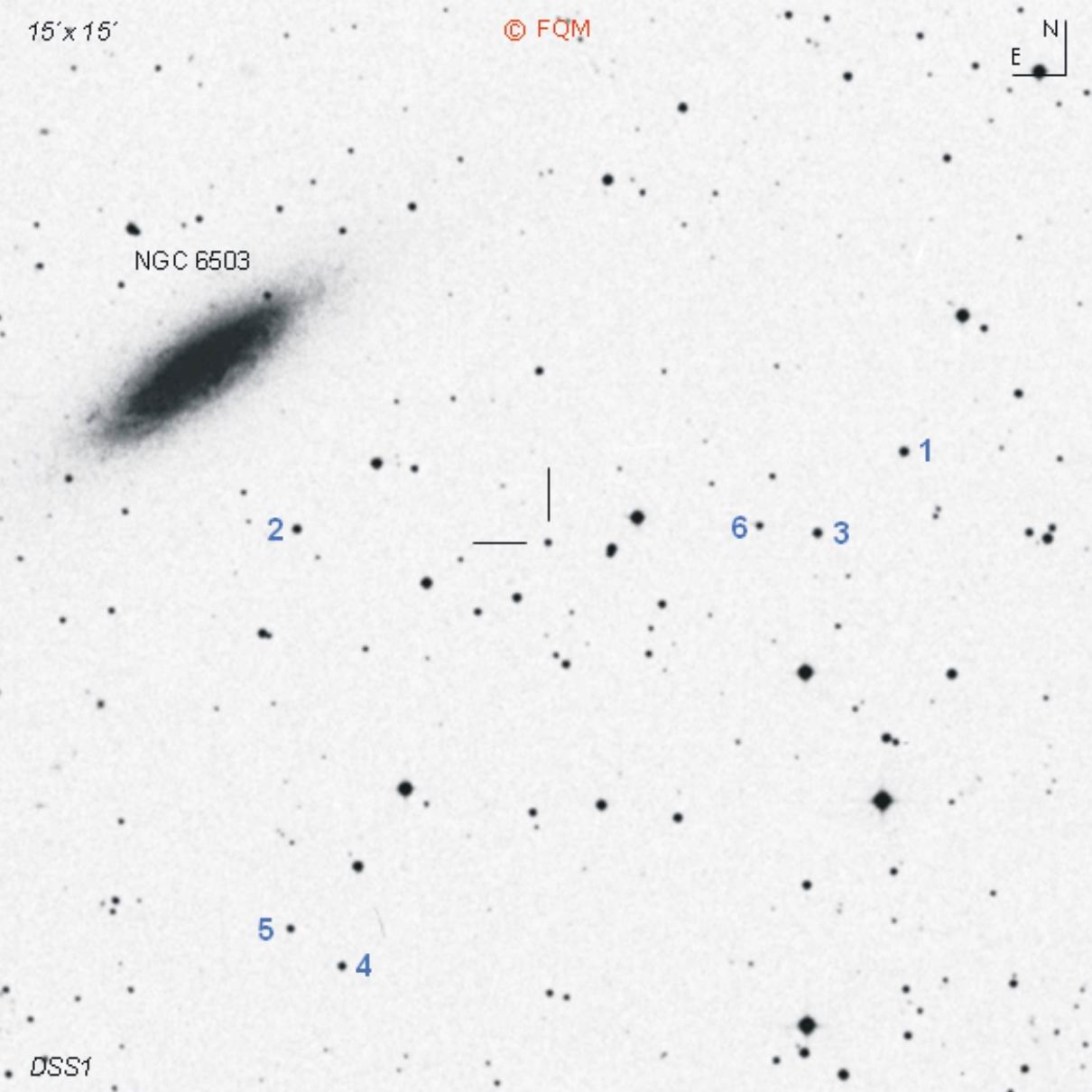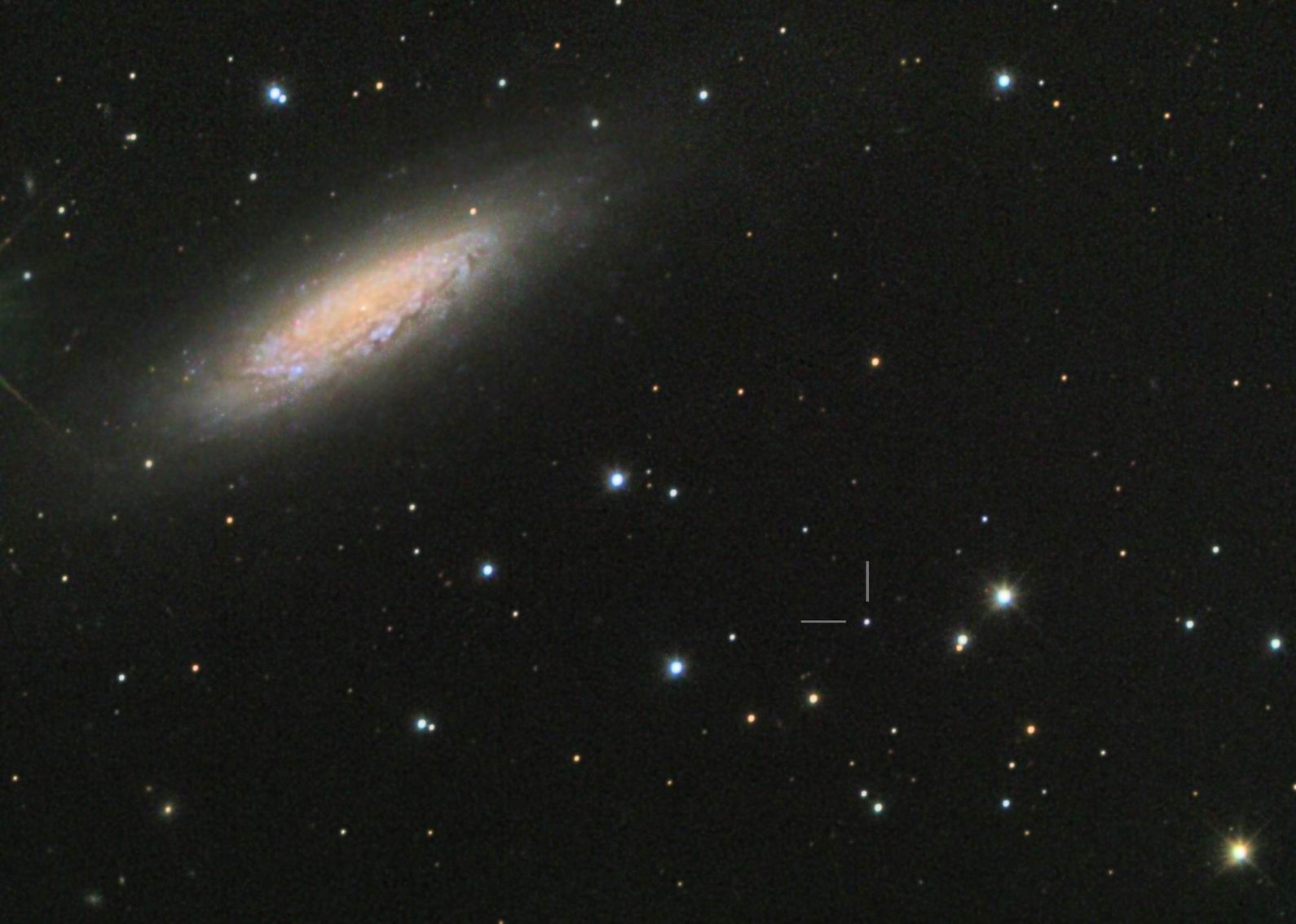
| Frankfurt Quasar Monitoring |
| S4 1749+70 |
| Cross-Identifications | HS 1749+7006, TXS 1749+701, QSO B1749+701 PKS 1749+701, GB6 B1749+7006, S5 1749+70 7C 1749+7006, RGB J1748.5+7005, 2E 3964 2MASS J17483284+7005506, 1E 1749.0+7006 1RXS J174832.9+700551, WMAP J1748+7006 1FGL J1748.5+7004, RX J1748.5+7006 |
| Equat. coordinates | RA 17 48 33.1 DE +70 05 50 (J2000) |
| Constellation | Draco |
| Type | BL Lac |
| Redshift (1) (2) | z=0.770 |
| Distance (2) (3) |
2633 Mpc |
| Total mag range (mv) (4) (5) | 14.7 - 17.7 |
| Catalog Magnitude (1) | 17.01 |
| Absolute Magnitude (1) | -26.0 MB |
| Light Travel-Time (2) | 6.489 × 109 yrs |

Comparison stars
| star | B | V |
| 1 | 15.340 (0.022) | 14.535 (0.039) |
| 2 | 15.021 (0.025) |
14.595 (0.041) |
| 3 | 15.165 (0.046) |
14.617 (0.029) |
| 4 | 15.748 (0.023) |
15.239 (0.084) |
| 5 | 16.046 (0.049) | 15.620 (0.034) |
| 6 |
16.416 (0.100) | 15.780 (0.084) |


| S4 1749+70
is a violently
variable BL
Lac object
in north-eastern Draco, only 5´SW of bright galaxy NGC 6503. S4 1749+70
was discovered as a radio source in 1972 during part 4 of
the 5-GHz Strong Source Survey (S4). The newly found object was
identified with a
17-mag stellar object on POSS plates, and was immediately classified as an unknown
quasi stellar object. Independently, S4 1749+70 was also identified as
a radio source by the
Westerbork 1415 MHz survey in 1974. Soon after, the optical counterpart
was found
to be variable at optical and radio wavelengths. Just one year later,
follow up spectroscopic investigations were carried
out with the 5-m Hale reflector at Palomar Observatory, which revealed
a featureless continuum. S4 1749+70 was
therefore classified as a BL Lac object. Despite its featureless spectrum, a weak emission line was detected in 1987, leading to a reliable redshift of z=0.770. This corresponds to a light travel time of about 6.5 Gyrs. S4 1749+70 can be best described as a variable, radio loud flat-spectrum radio source, which displays a core-jet structure (detected by radio interferometry). BL Lac object S4 1749+70 is a violently variable object with a total optical range of about 3 magnitudes (14.7 - 17.7 mag). CCD observers as well as visual observers shall use the comparison stars given above. Other sequences were published by the AAVSO and the Hamburg Quasar Monitoring project. The optical maximum of 14.7 mag [*] was detected on March 6, 2011, by Joseph Brimacombe, who observed with a 20-inch reflector and CCD camera from New Mexico. Initially, Brimacombe recognized this object as an unknown variable. The author advised him of the true nature of this object and redetermined the brightness using Brimacombe´s original fits-files, that he kindly provided for photometric reduction. To the knowledge of the author, this was the brightest optical state ever recorded for S4 1749+70. [* Photometric reduction based on APASS comparison stars] ____________
S4 1749+70 is located only 5´SW of bright galaxy NGC 6503 (see images above). NGC 6503 is some 16 million light-years away from earth. The colour image of NGC 6503 (see above) also shows the BL Lac object S4 1749+70, arbitrarily caught by Jim Misti in his deep and detailed image. Another interesting deep sky object can be found some 3.6° to the south. There we find the showpiece planetary NGC 6543, also known as the "Cat´s Eye Nebula". NGC 6543 is rich in details and is one of the brightest objects of its class. A more challenging deep sky object is another source of quasi-stellar photons: 3C 371. This is a bright 14-mag BL Lac object at a distance of about 0.6×109 light-years, only 1.6° east of S4 1749+70. |
| Arp, H., Sargent, W.L.W., et al. 1976, ApJ, 207, L13; A BL Lacertae Object near the Spiral Galaxy NGC 6503. Baath, L.B. 1984, IAUS, 110, 127B; VLBI and Compact Radio Sources. Symposium no. 110 held in Bologna, Italy, June 27-July 1, 1983. Edited by R. Fanti, K. Kellermann, and G. Setti. Nilsson, K., Pursimo, T., et al. 2003, A&A, 400, 95N; R-band imaging of the host galaxies of RGB BL Lacertae objects. Pauliny-Toth, I.I.K., Witzel, A., et al. 1978, AJ, 83, 451; The 5-GHz Strong Source Surveys. IV. Survey of the area between declination 35 and 70 degrees and summary of source counts, spectra and optical identifications. Pearson, T.J., Readhead, A.C.S. 1988, ApJ, 328, 114P; The milliarcsecond structure of a complete sample of radio sources. II - First-epoch maps at 5 GHz. Pérez-Torres, M.A., Marcaide, J.M., et al. 2004, A&A, 428, 847P; Absolute kinematics of radio source components in the complete S5 polar cap sample. II. First and second epoch maps at 15 GHz. Rector, T.A., Stocke, J.T. 2003, AJ, 125, 2447R; High-Resolution Radio Imaging of Gravitational Lensing Candidates in the 1 Jansky BL Lacertae Sample. Schramm, K.-J., Borgeest, U., et al. 1994, A&AS, 106, 349S; The Hamburg Quasar Monitoring program (HQM) at Calar Alto. III. Lightcurves of optically violent variable sources. Seielstad, G.A., Pearson, T.J., Readhead, A.C.S. 1983, PASP, 95, 842S; 10.8-GHz flux density variations among a complete sample of sources from the NRAO-Bonn 84 survey. Steinicke, W.; Katalog heller Quasare und BL Lacertae Objekte; Umkirch 1998. Stickel, M., Fried, J.W., Kuehr, H. 1989, A&AS, 80, 103S; Optical spectroscopy of 1 Jy BL Lacertae objects and flat spectrum radio sources. Stickel, M., Fried, J.W., Kuehr, H. 1993, A&AS, 98, 393S; The complete sample of 1 Jy BL Lac objects. II - Observational data. Véron-Cetty, M.-P., Véron, P. 2001, A&A 374, 92; A Catalogue of Quasars and Active Nuclei: 10th edition. Véron-Cetty, M.-P., Véron, P. 2003, A&A 412, 399; A Catalogue of Quasars and Active Nuclei: 11th edition. Véron-Cetty, M.-P., Véron, P. 2006, A&A 455, 776; A Catalogue of Quasars and Active Nuclei: 12th edition. Véron-Cetty, M.-P., Véron, P. 2010, A&A 518, 10; A Catalogue of Quasars and Active Nuclei: 13th edition. |
| Links: Landessternwarte Heidelberg Hamburg Quasar Monitoring APASS AAVSO Misti Mountain observatory |
| home |